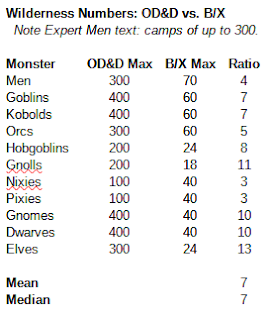Went to design some D&D encounters, and once again got thinking about the balance of monsters in the wilderness. Recall the top of the monster table in OD&D Vol-2:
Here we see what we now call the "humanoids" (at the time, "giant-types"), and there's a vast difference in the numbers appearing between the 1-HD types and the types larger than that. Previously we looked at summary statistics for the OD&D wilderness encounter tables, and saw enormous variation; most specifically in the danger between those army-types versus the non-army types. Let's take another perspective: here's a frequency table of the average total EHDs (Equivalent Hit Dice) for every separate encounter listed in the OD&D wilderness encounter tables.
Notice that the x-axis is roughly logarithmic, and that the results are bimodal: there's a big clump of encounters in the 20-50 EHD range, and a separate clump in the 200-500 range. Statistically this kind of bimodal distribution is often taken as a hint that something weird is going on, that you've mixed up two distinctly different populations in your data. In this case it's simply the difference between the army-types and the non-army-types in numbers. For monsters with maximum numbers of 100+, the average encounter EHD is about 200; for those maximum numbers below 100, the average encounter EHD is only about 40.How might we resolve this? Personally, I'm not entirely sure who was ever in favor of these giant armies in wilderness encounters in the first place. Even Arneson in the First Fantasy Campaign complained about them, and looked for interpretations to reduce their numbers. Here are some proposed options:
- Arneson in FFC has a system which asserts the full numbers appearing are for in-lair encounters only, and squads actually roaming in the wilderness outside be only 10-60% the lair numbers. On average that reduces numbers to about 1/3 listed.
- If we compare the average total EHDs above (40 for small-numbers, 200 for large-numbers), then we could roughly balance them together by reducing the army-types to about 1/5 the numbers listed for wandering wilderness encounters.
- If we look at the Moldvay-Cook B/X rules, we see what they did is reduce the numbers for humanoid types to about 1/7 the OD&D numbers. (Varying between 1/3 and 1/13 for the various types.) This is shown in the table below.
Hmmm, which solution to use? In particular with the Arneson FFC system, I've tossed this for a long time, and I've made myself something of a pariah in some circle for finding it simply infeasible on its face (his suggested system there is to actually pre-populate every hex of the campaign map with multiple encounters and play out interactions between them every campaign year). Aside from that, solely from the numbers we're looking at, two drawbacks I can identify: (a) I really, really don't want to have to make an additional roll and percent multiplication on top of all the other variegated rolls for every damned encounter (or even a simplified roll-and-divide-by-3 for every encounter), and (b) it reduces all wilderness types by a like amount, so the bimodal challenge for the numerous humanoids is not resolved. (Although in its favor, maybe there's some charm in only encountering a single dragon, chimera, gorgon, etc., in the wilderness, with batches reserved for lairs.) So that pivots us to look favorably, once again, at edits in the direction of the Moldvay-Cook rules.
A highly notable observation: The 1-HD types that appear in bulk-size in OD&D are precisely the types against which Fighting-Men get attacks as per their level (e.g., 10th level fighter gets 10 attacks per round against goblins)*. They are precisely the types against which magic such as charm person and hold person are effective. Many days now I think that it's this multiple-attack rule, present in OD&D/AD&D but missing from B/X, which marks the single biggest enormous mechanical difference between the two systems. It's possible that the wilderness army sizes in OD&D are scaled specifically to assume high-level fighters destroying 10 enemies every round of combat. I haven't specifically done the simulations needed to develop alternate EHDs under the fighter-many-attacks rule, but it's possible that alone would collapse the bimodal encounter curve down to a single well-balanced population. If we don't play with that as a universal, then we instead deserve a fairly radical reduction in humanoid numbers, as we see in B/X.
You may be able to detect that a lot of this thought process springboards and echoes our two recent discussions on the Wandering DMs about the Action Economy and how many things one can do in a single round (with fighter-many-attacks being the biggest difference between editions).
* Excepting Gnolls, but they too were 1-HD in the pre-publication draft of D&D, and then 2-HD afterward, so it's likely that their retention of army-sized numbers was an editing oversight.









